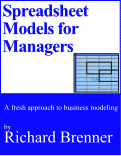

Spreadsheet Models for Managers
Getting Access to Spreadsheet Models for Managers
If  you use Excel to model businesses, business processes, or
business transactions, this course will change your life. You’ll learn how to create tools for yourself that will amaze
even you. Unrestricted use of this material is available in two ways.
you use Excel to model businesses, business processes, or
business transactions, this course will change your life. You’ll learn how to create tools for yourself that will amaze
even you. Unrestricted use of this material is available in two ways.
- As a stand-alone Web site
- It resides on your computer, and you can use it anywhere. No need for Internet access.
- At this Web site
- If you have access to the Internet whenever you want to view this material, you can purchase on-line access. Unlimited usage. I’m constantly making improvements and you’ll get them as soon as they’re available.
To Order On Line
| Order "Spreadsheet Models for Managers, on-line edition, one month" by credit card, for USD 69.95 each, using our secure server, and receive download instructions by return email. |
| Order "Spreadsheet Models for Managers, on-line edition, three months" by credit card, for USD 199.00 each, using our secure server, and receive download instructions by return email. |
| Order "Spreadsheet Models for Managers, downloadable hyperbook edition" by credit card, for USD 199.00 each, using our secure server, and receive download instructions by return email. |
To Order by Mail
Make your check payable to Chaco Canyon Consulting, for the amount indicated:
|
And send it to: Chaco Canyon Consulting 700 Huron Avenue, Suite 19C Cambridge, MA 02138 |
To use the course software you’ll need some other applications, which you very probably already have. By placing your order, you’re confirming that you have the software you need, as described on this site.

Spreadsheet Models for Managers
| A little bit of notation | 13/9 Session Links |
The text of your macros has to be processed before it can be executed. It’s parsed, and then it’s compiled into executable instructions. The software that performs those operations assumes that each line of the macro is syntactically complete. If not, it flags an error.
If some lines of your macro are very long, you might want to write them on two lines, but this causes a problem for the macro processor, which assumes that each line is complete. So if you want to break an expression across lines, you must use the line continuation character to indicate that the lines belong together.
It’s also useful to include comments in the text of your macros. They help you and others understand what you’re doing. Everything you type after a single-quote on any given line is considered a comment — except, of course, if the single-quote is part of a quoted string. Quoted strings in VBA, as in Excel, are wrapped in double-quotes.
It’s also possible to quickly comment or uncomment multiple lines at once. See the reading on Excel macros.
Last Modified: Sunday, 03-Aug-2025 03:54:37 EDT
We focus on function macros in this course because they’re more likely than command macros to make a real difference in your facility with constructing models. For instance, when your customer wants to see result streams displayed as [Month1, Month2, Month3, Q1 Total, Month4, Month5, Month6, Q2 Total, …], you probably realize that such a layout makes copy/paste and fill very inconvenient. A macro can provide a simple means of producing the preferred layout from a more easily maintained pure month structure. It’s also easy to construct macros for running sums and running differences. Can you think of other applications for function macros that make your models easier to build and maintain?



